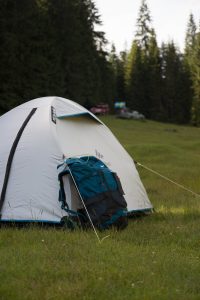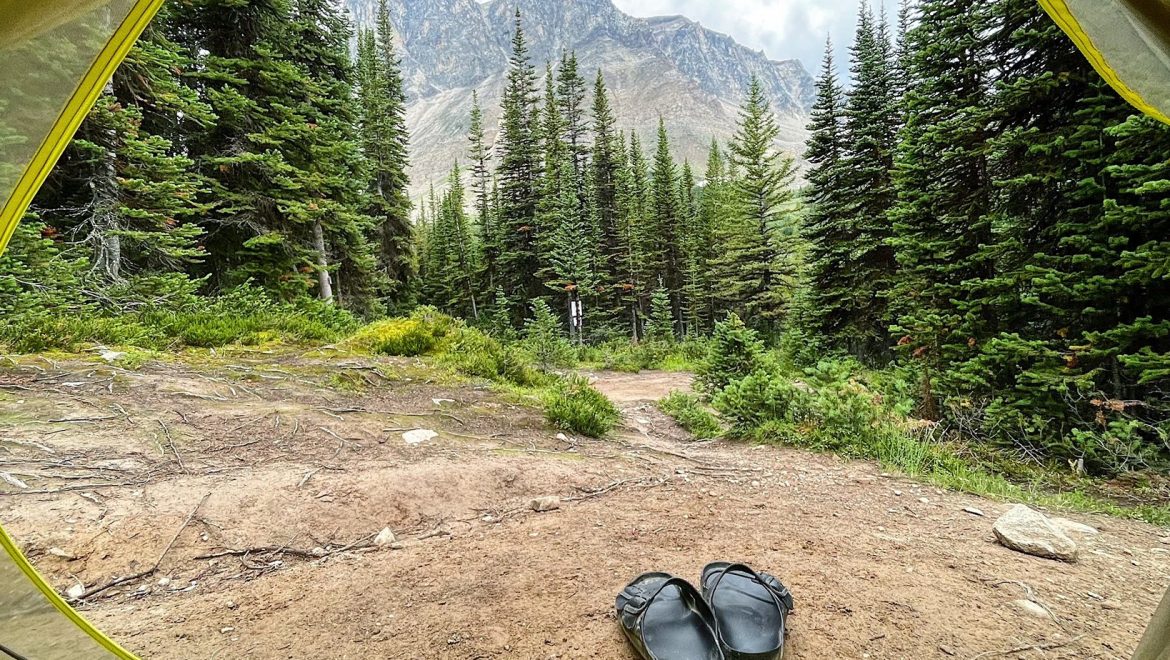The goal of any outdoor trip is to move through natural areas while avoiding damage to the land or waterways. To achieve this goal, it is important to understand how travel impacts nature. Travel damage occurs when surface vegetation or tiny communities of organisms are trampled beyond recovery. The resulting barren area leads to soil erosion and the development of undesirable trails. Backcountry travel often involves travel over existing trails and off-trail areas.
Travel on Trails

Land managers construct trails to provide identifiable routes that concentrate hikers, bikers, horseback riders and other trail users such as pack animals (most often horses carrying heavy loads). Constructed trails are themselves an impact on the land; however, they are a necessary response to the fact that people travel through natural areas.
Concentrating travel on trails reduces the likelihood that multiple routes will develop and scar the landscape. It is better to have one well-designed route than many poorly chosen paths. Using existing trails is recommended whenever possible. Encourage travellers to stay within the width of the trail and not shortcut trail switchbacks (trail zigzags that climb hillsides).
Travellers should provide space for other hikers if taking breaks along the trail. The Leave No Trace principles of off-trail travel should be practised if the decision is made to move off-trail for breaks. It is best to make sure that off-trail travel is authorized by the land manager before heading out.
Travel Off-trail

All travel that does not utilize a designated trail, such as travel to a remote area, searching for bathroom privacy, and explorations near and around campsites, is defined as off-trail. Two primary factors increase how off-trail travel impacts the land: durability of surfaces and vegetation, and frequency of travel (or group size).
- “Durability” refers to the ability of surfaces or vegetation to withstand wear or remain in a stable condition.
- “Frequency of use” (and use by large groups) increases the likelihood that a large area will be trampled, or that a small area will be trampled multiple times.
Surface Durability
The concept of durability is an important one for all backcountry travellers to understand. The natural surfaces described below respond differently to backcountry travel.
Rock, sand and gravel: These surfaces are highly durable and can tolerate repeated trampling and scuffing. However, mosses and lichens that grow on rocks are vulnerable to repeated scuffing. This is why it is best that you stay on trails in alpine areas and especially when travelling on alpine tundra.
Ice and snow: The impact of travel across these surfaces is temporary, making them good choices for travel assuming good safety precautions are followed and the snow layer is of sufficient depth to prevent underlying vegetation damage. Vegetation that grows in precarious high-altitude conditions is particularly vulnerable despite snow and ice cover. Pay attention to periods of thaw when trails must generally be avoided.
Vegetation: The resistance of vegetation to trampling varies. Careful decisions must be made when travelling across vegetation. Select areas with durable vegetation, or sparse vegetation that is easily avoided. Dry grasses tend to be resistant to trampling, whereas other plants and shrubs that are more vulnerable must be protected, such as those found on beaches, dunes, wet meadows, along lakes and waterways.
Inexperienced travellers tend to take routes that are starting to be trampled, which leads to the development of undesirable trails. As a general rule, travellers who must venture off-trail should spread out to avoid creating paths that encourage others to follow. Avoid vegetation whenever possible, especially on steep slopes where the effects of off-trail travel are magnified.
Wetlands: Water is a precious resource for wildlife. In more arid areas, avoid walking in puddles, mires and muskegs where small animals may live. Do not disturb the surface water on marshes, swamps and ponds.
Living soil: Sometimes referred to as “cryptobiotic crust,” or “crypto living soil.” Living soil consists of tiny communities of organisms that appear as a blackish and irregular raised crust upon the sand. It is only found in desert areas and is extremely vulnerable to traffic. This crust retains moisture and provides a protective layer that prevents erosion. One footstep can destroy this fragile soil. It is therefore important to use developed trails in these areas. Travel across living soil should only be done when absolutely necessary. Walk on rocks or other durable surfaces if you must travel off-trail. In broad areas of living soil where damage is unavoidable it is best to follow in one another’s footsteps so the smallest area of crust is affected, exactly the opposite rule from travel through vegetation. Living soil is also extremely vulnerable to mountain bicycle travel.
Camp on Durable Surfaces
Selecting an appropriate campsite is perhaps the most important aspect of low-impact backcountry use. It requires the greatest degree of judgment and information, and often involves making trade-offs between minimizing the ecological impact and the quality of the experience sought (social impact). A decision about where to camp should consider the level and type of use in the area, the fragility of vegetation and soil, the likelihood of wildlife disturbance, an assessment of previous impacts, and your party’s potential to cause or avoid impact.
Choosing a suitable place to camp is perhaps the most important aspect of low-impact outdoor recreation. This requires a high degree of knowledge and judgment. It is often a trade-off between ecological impacts and the quality of experience that is sought (social impact). Choosing camp should consider the following :
- the frequency and type of use of the area,
- the fragility of the vegetation and soil,
- the potential for disturbing wildlife,
- an assessment of past damage,
- the potential for its group to cause or avoid impacts.
Choosing a Campsite in High-use Areas

Follow the land manager’s rules for site selection at all times. Camp in designated campsites whenever possible. If there are no designated sites, avoid camping near lakes, streams and trails, and choose one that is not exposed. Privacy and solitude can be found even in busy areas when choosing a site in a more secluded location. It is best to camp at least 60 m (200 ft. or about 70 adult paces) from the water’s edge so as not to block wildlife access.
Plan for enough time and energy at the end of the day to select an appropriate site. Fatigue, bad weather and late departures are not acceptable excuses for choosing poor or fragile campsites. It is generally best to camp on sites already impacted where further use will not cause noticeable impact. In popular spots, these sites are easy to find because their vegetation is already gone. It is also possible to find a site that is naturally devoid of vegetation, such as rocky slabs or sandy surfaces.
On degraded sites, install tents, walkways, and kitchen area on areas already damaged. The goal is to limit impacts to areas that have already been impacted to avoid creating new impacts elsewhere. When we break camp, we make sure that everything is clean and attractive for the campers who will follow.
Camping in Undisturbed Remote Areas

Areas with little use don’t show obvious signs of impact. They are more frequent in backcountry. Visit those areas only if you are commited and have learned the Leave No Trace techniques.
In pristine places, it is best to spread out tents, avoid repetitive traffic routes and move camp every night. The objective is to minimize the number of times any part of the site is trampled.
Setting up camp
- disperse the tents and kitchen area on durable surfaces
- wear soft shoes around camp
- minimize activity around the cooking area and backpacking areas
- choose durable surfaces such as large rock slabs for the kitchen sites
- set the kitchen and tents 100 yards (meters) apart for bear safety
When walking on site, avoid crushing vegetation and take alternate paths to get water. Minimize the number of trips to the water source by carrying containers. Always check regulations, but camping 60 m (200 feet or about 70 adult steps) from water is a good rule of thumb.
When leaving, take the time to restore the site to its natural state. Cover scuffed areas with natural materials (such as pine needles, twigs and dried leaves), brush out footprints, and rake matted grassy areas with a stick or branch to help the site recover. This way the site will no longer look like a campsite and other campers will be reluctant to use it. The less often a pristine site is used, the more likely it is to retain its natural character.

Mountainous and Arid areas
The best campsites in mountainous or arid areas are on durable surfaces. These include rock and gravel, or on sites that have been so highly impacted that further use will not create more wear. If choosing this type of site, make sure your spot is large enough to accommodate your entire group.
An undeveloped site, almost never used, is ideal in mountainous or arid areas. Provided it is on a very durable surface, free of vegetation. Surfaces made of rocks, gravel or sand are excellent choices. Camping on patches of vegetation (moss, lichen, etc.), on narrow riverbanks, or on live ground (in desert areas) is not recommended. Beware when camping on the sandy bottom of a river and in an area prone to flash floods.
Never rake or remove organic materials such as leaves, and do not move rocks and gravel unnecessarily. Organic material helps to protect from trampling, limits soil compaction, releases plant nutrients and reduces erosion. Disturbing lichen-coated rocks can leave a visible impact for hundreds of years. Once overturned, their lichen will take a very long time to grow back.
Camping in Canyon
A canyon is a river valley characterized by its narrowness, depth, and steepness of rock walls. The narrow bands of land and water in canyons offer little room for human activity. Campsites are often designated in these environments. It is generally best to choose sites that are already developed on beaches, sandbars, or unvegetated areas below the high water mark (the trace left by the highest level reached by flood waters).
Previous Principle
Next Principle


